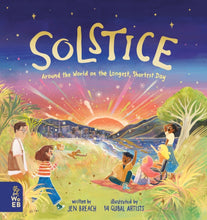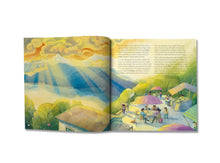
Just two times each year - an event called the solstice - Earth leans closest to our home star, the Sun. Since ancient times, people have used the Sun as a timekeeper. They knew that the length of daylight changes in a regular way and celebrated the solstice as a signal of changing seasons. The Longest, Shortest Day imparts scientific and cultural information using the global experience of a solstice as its scientific core, and the descriptions of children's lives at each latitude as the cultural narrative. It is a browsable nonfiction appealing to informationally-minded thinkers aged 7-11.
Enhancing the text and illustrations are fascinating infographics about geography, hours of sunlight, sunrise and sunset times, and how the Earth's tilt creates solstices and seasons. A global event needs a global perspective: non-traditional families, interesting facts that crop up in each account (e.g. in the Chinese entry we learn that pandas need to play or else they get sad). Plus, illustrators for each location represent their home countries with authority and beauty.
Read our review on justimagine.co.uk
Tagged people and places





















